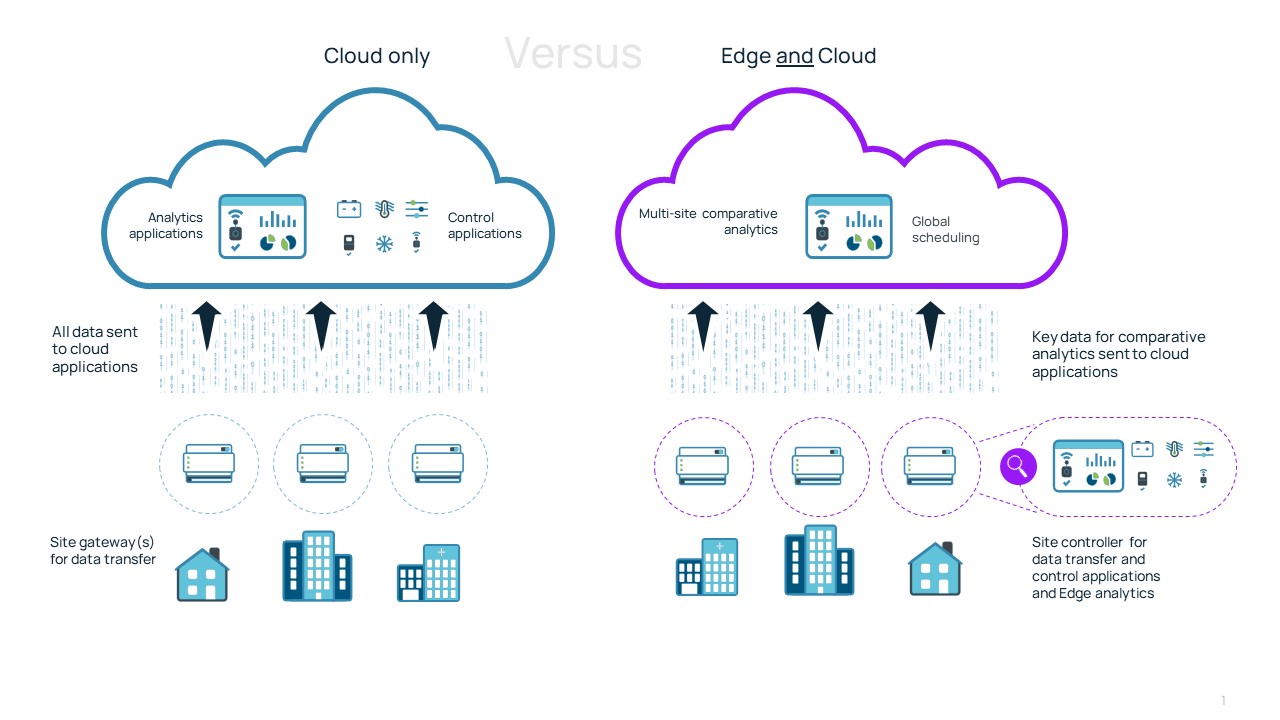
|
April 2021 |
[an error occurred while processing this directive] |
| Managing the Edge: Edge vs Cloud from https://www.j2inn.com/blog/managing-the-edge? |
Chris Irwin | 17 Mar 2021 |
[an error occurred while processing this directive]
| Articles |
| Interviews |
| Releases |
| New Products |
| Reviews |
| [an error occurred while processing this directive] |
| Editorial |
| Events |
| Sponsors |
| Site Search |
| Newsletters |
| [an error occurred while processing this directive] |
| Archives |
| Past Issues |
| Home |
| Editors |
| eDucation |
| [an error occurred while processing this directive] |
| Links |
| Software |
| [an error occurred while processing this directive] |
As
a veteran of the building automation software market, I have sat
through many conference presentations about the value of building data
and how, in the future, it will all be connected to and managed in the
cloud. I have also seen the widespread adoption of cloud-based
monitoring, as the number and type of cloud applications available in
the market multiplies.
At the same time, the range of
low-cost wireless devices capable of collecting useful data about
buildings and equipment has expanded. There are many companies offering
services focussed on using such sensors to harvest data which is
transmitted, via gateways, to cloud applications to enable businesses
to better understand indoor air quality, space utilization and other
aspects of building operation.
While this
progress is good, as with any new “fashionable” topic or trend, I have
encountered much over-hyping of the value of data being stored “in the
cloud”. Although there is far too much data languishing on hard drives
located on site, inaccessible for analysis, the solution is not just to
send everything to the cloud! The solution is to establish open data
formats that make the data fully portable, and use appropriate
application software that can analyze it wherever is most appropriate;
at the edge, the enterprise or in the cloud, in order to improve
building performance and efficiency.
Not ALL
data needs to be sent and logged in the cloud. Not only is it
potentially expensive to do so, in terms of the cost of using the cloud
services provider since they charge according to data volume, but it is
unnecessary and inappropriate. Yes, if you want to compare the
performance of equipment items or energy consumption between various
buildings then you need to get data up to the cloud for such analysis.
But if you want to identify whether a valve or damper is stuck, the
analytics rule you will need to apply to identify will likely require
data every few seconds and can be easily run in an edge device on site.
It is unnecessary to send 10 second interval data up to the cloud to
make such a diagnostic evaluation. Whilst I agree that sometimes remote
management of devices could be simpler and most appropriate, the idea
of running PID loop control of an AHU or even determining pump
changeover routines from the cloud doesn’t.
Since
a building is an entity with boundaries and a set of equipment and
devices necessary for its operation, it makes perfect sense for it to
have its own management in terms of automation systems. I will call
this the “Edge Manager”. The problem with buildings is that the Edge
Manager has not been smart enough or easy enough to use (until now),
and so many buildings are being run sub-optimally. Many automation
systems currently installed in buildings were designed and installed
before the age of ubiquitous computing, which means their software is
not designed to enable integration of IoT devices. This is why new IoT
providers have included so called “IoT gateways” in their proposition,
so as to get the data off-site, in an entirely separate way from the
remote connection used to manage the automation system. This doesn’t
make sense; it is yet another example of how the market is siloed, with
each application and vendor offering separate solutions that do not
easily communicate.
It makes more sense to
have an Edge Manager on-site capable of managing the automation system
and handling the IoT data as well. Not only does this enable a single
connection for all data transmission northbound to the cloud, it also
enables data sharing to achieve building optimization locally and avoid
unnecessary duplication of sensors.
One of the
original drivers for sending data up to the cloud was that the cost of
implementing edge analytics was prohibitively high due to the cost of
processing power and memory. Over the last 10 years, however, the cost
of the required electronics (both processors and memory) has fallen.
It is now feasible to run even video tracking analytics, which is way
more demanding than automation analytics, on something as inexpensive
as a Raspberry Pi computer, which costs less than $35. We have reached
a point where the cost of packaging the electronics and getting the box
to site and installed is far more important than the cost of the
electronics necessary to achieve a useful Edge management. It makes
little sense to install multiple IoT gateways that are only capable of
passing wireless sensor data up to a cloud app when you can install one
Edge Manager that will handle all the sensors and the existing
automation system functions. This easier, more efficient solution is
only a few dollars more than a basic gateway.
Although
the cost of the equipment is comparable to other solutions, the cost of
on-site deployment is where proponents of cloud-based solutions have
had a stronger argument. The expertise required to integrate multiple
systems and devices is in short supply and sending such people to site
is not usually cost-effective. Plus, the cost of maintaining the
on-site management device is perceived as higher than if the
application software is all run at cloud level. Imagine a world in
which the Edge Manager can be fully configured remotely from anywhere,
is automatically upgradeable from a cloud server, and if it fails the
hardware platform can be simply unplugged and replaced, with a software
back-up image automatically restored from a cloud server. In this
world, Edge Management of buildings provides resilience since one is
not dependent on cloud connectivity for the day to day control and
optimization of the building. Only the data necessary for higher level
analytics and reporting is sent northbound to the whichever cloud
service being used.
 FIN Framework provides
the software to power the Edge Manager products of the future that the
market has needed for so long. FIN has been designed to support the
latest IoT data standards and is able to run on low-cost hardware
platforms. The software framework can integrate with and manage HVAC,
lighting metering and other building systems, with simple wizard-based
set-up, and easy and secure Edge2Cloud remote connectivity.
FIN Framework provides
the software to power the Edge Manager products of the future that the
market has needed for so long. FIN has been designed to support the
latest IoT data standards and is able to run on low-cost hardware
platforms. The software framework can integrate with and manage HVAC,
lighting metering and other building systems, with simple wizard-based
set-up, and easy and secure Edge2Cloud remote connectivity.
[an error occurred while processing this directive]
[Click Banner To Learn More]
[Home Page] [The Automator] [About] [Subscribe ] [Contact Us]